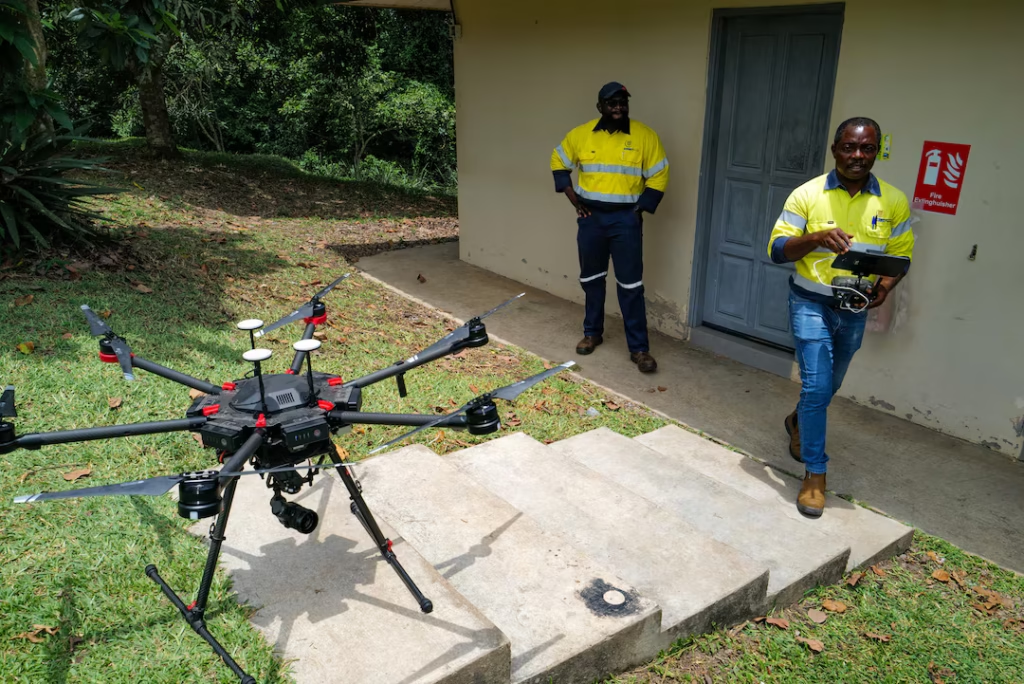As global gold prices continue their upward climb, driven by central bank stockpiling and geopolitical instability, gold mines across West Africa are turning to high-tech solutions—particularly drones—to protect their concessions from illegal mining operations, commonly referred to as “wildcat” mining.
At Gold Fields’ Tarkwa mine in southwestern Ghana, drone operators scan the vast 210-square-kilometer terrain daily for signs of intrusion. Recently, drone footage detected movement near a remote area of the mine. Within 20 minutes, a rapid-response unit comprising 15 personnel and armed police arrived at the scene. What they found was typical: hastily abandoned equipment, trenches dug by hand, and contaminated pools tainted with mercury and cyanide—clear indicators of illegal mining activity.
Seven diesel-powered water pumps and a locally manufactured gold extraction unit known as a chanfan were seized.
Rising Tensions, Rising Toll
Since late 2024, confrontations between wildcat miners and security forces at large-scale mining operations have claimed the lives of nearly 20 illicit miners across Ghana, Guinea, and Burkina Faso. Companies such as Newmont, AngloGold Ashanti, and Nordgold have reported serious incursions that have at times halted production for weeks.
No injuries to official mine staff have been reported, but the scale and frequency of the conflicts have led to increased demands for military protection from mining companies operating in the region.
“The higher the gold price rises, the more conflict we’ll see between industrial and informal miners,” said Ulf Laessing, Sahel program director at Germany’s Konrad Adenauer Foundation. With some analysts projecting gold to reach $5,000 an ounce, pressure on mining sites is expected to intensify.
Informal Gold Mining: A Lifeline and a Liability
A May 2025 UN report estimates that nearly 10 million people in Sub-Saharan Africa depend on artisanal and small-scale mining (ASM) for their livelihoods. In West Africa, unregulated miners account for up to 30% of total gold production, underscoring both the economic necessity and regulatory challenge they represent.

For miners like Famanson Keita, a 52-year-old in Senegal’s gold-rich Kedougou region, illegal mining offers a survival mechanism in a region where formal jobs are scarce and farming alone is insufficient.
“We were promised development and jobs when the companies arrived. Instead, most of our youth are working without contracts or proper wages. We have no choice but to return to the land to survive, even if it means mining illegally,” Keita shared.
However, this once small-scale survival activity has now escalated into a complex network involving local cartels and foreign backers, particularly Chinese nationals, operating with industrial equipment in protected forests and rivers.
Technology vs. Illicit Gold Rush
To combat the spread of wildcat mining, Ghana’s Minerals Commission has launched a cutting-edge initiative involving 28 surveillance drones and an AI-powered control center. The technology allows for real-time tracking of illegal operations and can remotely disable excavators operating outside of licensed areas.
“This is a fight we can win with technology—if we commit to full implementation,” says Sylvester Akpah, consultant on the drone and AI project.
Meanwhile, companies are footing the bill for extra security. One mine operator revealed spending nearly $500,000 annually on surveillance and rapid-response measures, including drones, at the expense of investment in local community projects.
The Cost of Security
The security burden is now part of negotiations between mining companies and governments. In Ghana, major mining firms have requested military deployments, particularly at high-risk sites. According to sources involved in discussions, the government has agreed in principle but expects mining companies to cover deployment costs—estimated at 250,000 Ghanaian cedis (roughly $18,100) per team of 50 personnel per day.
“Ideally, we would have military presence at all sites, but that’s not financially or logistically feasible. So we are prioritizing based on risk,” explained Ahmed Dasana Nantogmah, Chief Operating Officer of Ghana’s Chamber of Mines.
Smuggling and Lost Revenue
In addition to safety and environmental risks, gold smuggling remains a significant concern. A recent Swissaid report revealed that Ghana lost over 229 metric tons of artisanal gold to illegal export between 2019 and 2023, much of it shipped through porous borders by unregulated operators.
“These activities rob the country of revenue, reduce mine lifespans, and endanger both the ecosystem and the miners themselves,” said Marc Ummel, a Swissaid researcher.
A Delicate Balancing Act
The wildcat mining crisis in West Africa highlights the complex tension between economic desperation, environmental degradation, and industrial security. While formal mining operations press forward with drones and artificial intelligence, millions of citizens remain dependent on gold panning and digging for survival.
For governments and mining firms alike, the challenge lies in finding a balance—between enforcement and engagement, between technology and tradition, and ultimately, between profit and people.















